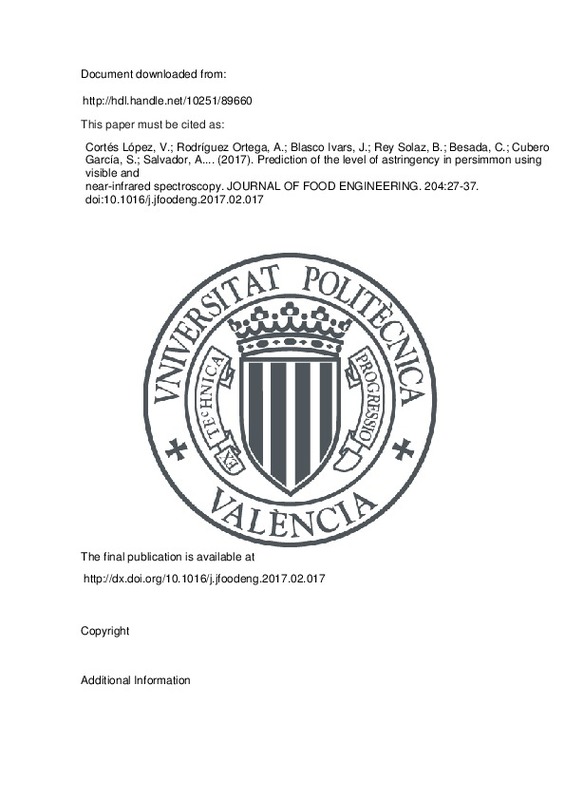JavaScript is disabled for your browser. Some features of this site may not work without it.
Buscar en RiuNet
Listar
Mi cuenta
Estadísticas
Ayuda RiuNet
Admin. UPV
Prediction of the level of astringency in persimmon using visible and near-infrared spectroscopy
Mostrar el registro sencillo del ítem
Ficheros en el ítem
| dc.contributor.author | Cortes-Lopez, Victoria
|
es_ES |
| dc.contributor.author | Rodríguez Ortega, Alejandro
|
es_ES |
| dc.contributor.author | Blasco Ivars, José
|
es_ES |
| dc.contributor.author | Rey Solaz, Beatriz
|
es_ES |
| dc.contributor.author | Besada, Cristina
|
es_ES |
| dc.contributor.author | Cubero García, Sergio
|
es_ES |
| dc.contributor.author | Salvador, Alejandra
|
es_ES |
| dc.contributor.author | Talens Oliag, Pau
|
es_ES |
| dc.contributor.author | Aleixos Borrás, María Nuria
|
es_ES |
| dc.date.accessioned | 2017-10-20T07:09:55Z | |
| dc.date.available | 2017-10-20T07:09:55Z | |
| dc.date.issued | 2017 | es_ES |
| dc.identifier.issn | 0260-8774 | es_ES |
| dc.identifier.uri | http://hdl.handle.net/10251/89660 | |
| dc.description.abstract | [EN] Early control of fruit quality requires reliable and rapid determination techniques. Therefore, the food industry has a growing interest in non-destructive methods such as spectroscopy. The aim of this study was to evaluate the feasibility of visible and near-infrared (NIR) spectroscopy, in combination with multivariate analysis techniques, to predict the level and changes of astringency in intact and in the flesh of half cut persimmon fruits. The fruits were harvested and exposed to different treatments with 95 % CO2 at 20 ºC for 0, 6, 12, 18 and 24 h to obtain samples with different levels of astringency. A set of 98 fruits was used to develop the predictive models based on their spectral data and another external set of 42 fruit samples was used to validate the models. The models were created using the partial least squares regression (PLSR), support vector machine (SVM) and least squares support vector machine (LS-SVM). In general, the models with the best performance were those which included standard normal variate (SNV) in the pre-processing. The best model was the PLSR developed with SNV along with the first derivative (1-Der) pre-processing, created using the data obtained at six measurement points of the intact fruits and all wavelengths (R2=0.904 and RPD=3.26). Later, a successive projection algorithm (SPA) was applied to select the most effective wavelengths (EWs). Using the six points of measurement of the intact fruit and SNV together with the direct orthogonal signal correction (DOSC) pre-processing in the NIR spectra, 41 EWs were selected, achieving an R2 of 0.915 and an RPD of 3.46 for the PLSR model. These results suggest that this technology has potential for use as a feasible and cost-effective method for the non-destructive determination of astringency in persimmon fruits. | es_ES |
| dc.description.sponsorship | This work has been partially funded by the Institute Nacional de Investigacion y Tecnologia Agraria y Alimentaria de Espana (INIA) through research projects RTA2012-00062-004-01/03, RTA2013-00043-C02, and RTA2015-00078-00-00 with the support of European FEDER funds, and by the Conselleria d' Educacio, Investigacio, Cultura i Esport, Generalitat Valenciana, through the project AICO/2015/122. V. Cortes thanks the Spanish MEC for the FPU grant (FPU13/04202). | en_EN |
| dc.language | Inglés | es_ES |
| dc.relation.ispartof | JOURNAL OF FOOD ENGINEERING | es_ES |
| dc.rights | Reserva de todos los derechos | es_ES |
| dc.subject | Diospyros kaki | es_ES |
| dc.subject | Fruit internal quality | es_ES |
| dc.subject | Soluble tannins | es_ES |
| dc.subject | Near-infrared spectroscopy | es_ES |
| dc.subject | Chemometrics | es_ES |
| dc.subject.classification | EXPRESION GRAFICA EN LA INGENIERIA | es_ES |
| dc.subject.classification | TECNOLOGIA DE ALIMENTOS | es_ES |
| dc.title | Prediction of the level of astringency in persimmon using visible and near-infrared spectroscopy | es_ES |
| dc.type | Artículo | es_ES |
| dc.identifier.doi | 10.1016/j.jfoodeng.2017.02.017 | es_ES |
| dc.relation.projectID | info:eu-repo/grantAgreement/MINECO//RTA2012-00062-C04-01/ES/Nuevas técnicas de inspección basadas en espectrometría para la estimación de propiedades y determinación automática de la calidad interna y sanidad de productos agroalimentarios aplicadas a líneas de inspección y manipulación (SPEC-DACSA)/ | |
| dc.relation.projectID | info:eu-repo/grantAgreement/MINECO//RTA2013-00043-C02-02/ES/Caracterización morfológica, agronómica y molecular de nuevo material vegetal de caqui/ | |
| dc.relation.projectID | info:eu-repo/grantAgreement/MINECO//RTA2015-00078-00-00/ES/Sistemas no destructivos para la determinación automática de la calidad interna de frutas en línea utilizando métodos ópticos e información espectra/ | |
| dc.relation.projectID | info:eu-repo/grantAgreement/Generalitat Valenciana//AICO%2F2015%2F122/ES/ | |
| dc.relation.projectID | info:eu-repo/grantAgreement/MECD//FPU13%2F04202/ES/FPU13%2F04202/ | |
| dc.rights.accessRights | Abierto | es_ES |
| dc.date.embargoEndDate | 2018-07-31 | es_ES |
| dc.contributor.affiliation | Universitat Politècnica de València. Departamento de Mecanización y Tecnología Agraria - Departament de Mecanització i Tecnologia Agrària | es_ES |
| dc.contributor.affiliation | Universitat Politècnica de València. Departamento de Tecnología de Alimentos - Departament de Tecnologia d'Aliments | es_ES |
| dc.contributor.affiliation | Universitat Politècnica de València. Departamento de Ingeniería Gráfica - Departament d'Enginyeria Gràfica | es_ES |
| dc.description.bibliographicCitation | Cortés López, V.; Rodríguez Ortega, A.; Blasco Ivars, J.; Rey Solaz, B.; Besada, C.; Cubero García, S.; Salvador, A.... (2017). Prediction of the level of astringency in persimmon using visible and near-infrared spectroscopy. JOURNAL OF FOOD ENGINEERING. 204:27-37. doi:10.1016/j.jfoodeng.2017.02.017 | es_ES |
| dc.description.accrualMethod | S | es_ES |
| dc.relation.publisherversion | http://dx.doi.org/10.1016/j.jfoodeng.2017.02.017 | es_ES |
| dc.description.upvformatpinicio | 27 | es_ES |
| dc.description.upvformatpfin | 37 | es_ES |
| dc.type.version | info:eu-repo/semantics/publishedVersion | es_ES |
| dc.description.volume | 204 | es_ES |
| dc.relation.pasarela | S\329804 | es_ES |
| dc.contributor.funder | Instituto Nacional de Investigación y Tecnología Agraria y Alimentaria | |
| dc.contributor.funder | Ministerio de Educación y Ciencia |







![[Cerrado]](/themes/UPV/images/candado.png)

